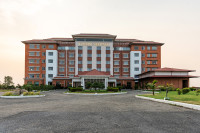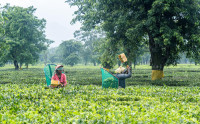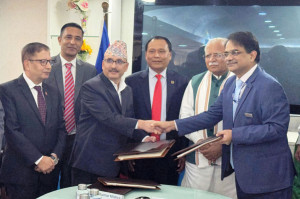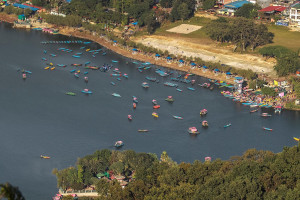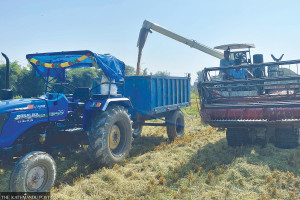Money
Report: Goma Air crash due to ‘very low’ visibility
‘Very low’ visibility prevented the flight crew of Goma Air Flight 409 from seeing the runway at Lukla Airport until seconds before the LET 410 aircraft slammed into a fog-covered mountainside, a government fact-finding committee said on Friday.
Sangam Prasain
‘Very low’ visibility prevented the flight crew of Goma Air Flight 409 from seeing the runway at Lukla Airport until seconds before the LET 410 aircraft slammed into a fog-covered mountainside, a government fact-finding committee said on Friday.
The flight captain and co-pilot were killed in the crash that occurred last May, 130 feet from the runway. The Czech-made aircraft was on a cargo flight from Kathmandu to Lukla in the Himalaya.
A crash report of Goma Air Flight 409, since renamed Summit Air, submitted to the Tourism Ministry after a seven-month-long investigation, said that the crew were confronted with the lowest amount of visibility and dense fog as soon as the aircraft entered the Lukla Valley.
The valley was blanketed with dense fog, and the LET 410 remained inside it for at least 4 minutes. “The co-pilot sighted the runway 64 seconds before the accident. The aircraft was flying at an elevation of 9,100 feet at this time,” the report said.
“The runway disappeared from sight again. At this point, the plane was out of position, it turned almost 15 degrees towards the right side of the runway,” the report said, outlining the flight’s frantic final seconds before the crash.
Trapped in almost nil visibility, the aircraft descended to 8,500 feet while the runway threshold height is 8,900 feet. In that situation, the flight crew had no alternative but to climb immediately.
“The flight commander instantly tried to correct the error. He made an effort to steer the aircraft along the centerline of the runway, but with landing gears down, there was excessive drag which caused it to stall,” the report said.
The stall warning that alerts the pilot to an approaching stall begins 13 seconds before the crash. The aircraft hit a small tree with its left wing before smashing into sloping terrain 130 feet short of the runway.
“The flight captain was in such a position that he had no time to carry out the recovery process,” said Tara Air’s Senior Captain Bodhraj Niraula, a member of the investigation committee. The aircraft was not in track. The runway was not visible. It was flying low.
“Even if the pilot had attempted a go-around, he would not be aware of his position as all the terrain in the narrow valley was covered with dense fog,” he said.
Niraula said that both air traffic control and the pilot had violated the standard operating procedure. Airport authorities clearly failed to adhere to the conditions, and did not bother to temporarily shut down the airport.
The flight captain, on the other hand, decided to land at the airport, which is dubbed one of the ‘world’s most dangerous airports’, in weather that was fluctuating every few minutes.
Was the flight captain under stress or suffering from fatigue? “This issue cannot be ruled out,” said Tri Ratna Manandhar, chairman of the probe committee.
“Although it has not been fully established by any evidence, the flight crew looked stressed to some extent when they were chatting with each other,” he said. “It was due to frequent changes in the weather pattern.”
Goma Air Flight 409 was the crew’s fifth flight that day. After 10 miles into the flight, the crew was informed about heavy rain in Lukla.
“At some point, the crew had thought about turning back, but they were informed that there was heavy congestion at Kathmandu airport,” said Manandhar. “They decided to continue rather than spend hours holding in the sky.”
There were lots of aircraft in a holding position in the east and west of Kathmandu. Ground traffic was also very busy. After a few minutes, the crew were informed that the weather in Lukla had improved as the rain had also stopped.
Heavy congestion at Tribhuvan International Airport in Kathmandu could also be one of the key contributing factors to the crash.
The investigation committee has recommended that the aviation regulator Civil Aviation Authority of Nepal (Caan) consider the congestion at TIA very seriously. It has also said that the runway at Lukla Airport can be extended by 100 feet, and that Caan needs to respond to this matter urgently.




 23.12°C Kathmandu
23.12°C Kathmandu



